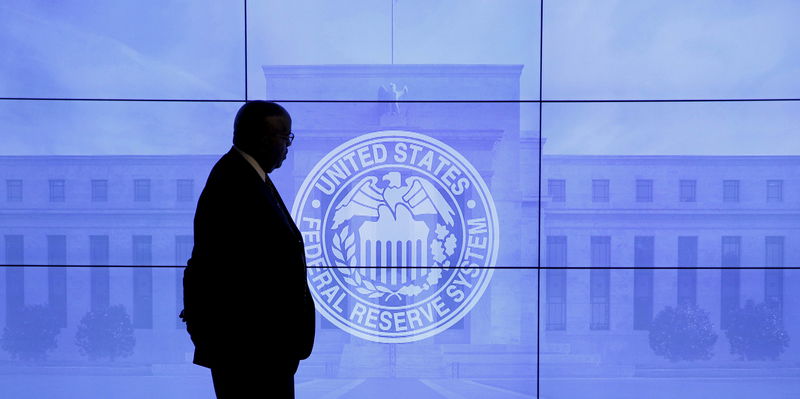(Bloomberg) -- Judging from the bond market, the Federal Reserve is some combination of ineffective and lucky.
As policy makers have pushed the benchmark federal funds rate higher, long-term Treasury yields have barely budged, narrowing the gap with short-term yields to the smallest in a decade. That’s helped keep borrowing costs relatively low for consumers and companies, enabling steady economic growth and fueling continued gains in the stock market.
The trend is calling into question the Fed’s power to affect long-term borrowing costs even as it helps the central bank. That’s because it indicates Fed officials can continue to raise interest rates gradually, storing up more ammunition to fight the next downturn, without fully removing the economy’s proverbial punch bowl.
“These rate hikes -- they’re not packing the same punch that they would have years ago,” said Omair Sharif, senior U.S. economist at Societe Generale in New York. “Because there hasn’t been much of a reaction -- other than the front end -- and the point is to drain the punch bowl, it potentially is an argument for at the very least staying on the path you’ve laid out next year.”
The Fed has raised its main rate twice this year to a target range of 1 percent to 1.25 percent, and officials have signaled that another increase will come in December. They are projecting three quarter-point hikes in 2018, assuming the economy performs in line with expectations.
Conundrum, Glut
It’s not unusual for the so-called yield curve to flatten when the Fed is tightening, but this latest bout has raised some eyebrows. Historically, longer-term rates rise during a hiking cycle, just at a slower pace than short-term rates. This time, they’re moving sideways, a phenomenon reminiscent of the mid-2000s.
“What’s concerning isn’t so much the flattening of the curve, but it’s the way that the curve is flattening,” said Gennadiy Goldberg, an interest-rate strategist at TD Securities in New York.
Fed policy makers are clearly paying attention. Dallas Fed President Robert Kaplan has suggested that long-term yields may be staying low because market participants expect weak future growth, while New York Fed President William Dudley has suggested the flat yield curve reflects low borrowing costs outside the U.S.
The idea that policy abroad is causing the trend is a fairly common interpretation. The European Central Bank and Bank of Japan both have negative interest rates and continue to buy bonds to galvanize their economies, though the ECB is set to reduce its purchases starting in January. That’s left a lot of money sloshing around the global financial system, and it’s stoking demand for any positive-yielding bonds that the U.S. is willing to supply -- keeping longer-term bond prices high and yields low.
If that’s the explanation, the Fed probably has limited ability to boost long-term interest rates.
More Room
The central bank might be fortunate in its impotence. Stubbornly low long-term rates mean that even as the Fed lifts the policy rate -- giving itself room to cut it in the next recession -- it isn’t stopping the party.
Borrowing to buy a house remains historically cheap. Businesses, long hesitant to invest, are finally putting money into new machines and technology. Workers continue to come in off the sidelines, causing the labor-force participation rate to stabilize despite demographic trends that suggest it ought to fall.
Another silver lining to easy financial conditions: They may give officials a chance to eke out a few more hikes than otherwise would be the case. Economists agree that policy makers can’t lift their benchmark interest rate as high as in previous expansions. Yet officials are eager to creep further away from zero before the next recession hits so they’ll have more room to react.
“They can probably tighten more on the funds rate than they would otherwise,” said Michael Feroli, chief U.S. economist at JPMorgan Chase & Co in New York. “It gives them, ideally, at the end of the cycle some more capacity to cut rates.”
Still, there’s reason to worry. Low 10- and 30-year rates suggest that markets may doubt the Fed’s ability to lift inflation toward their 2 percent goal, which is bad news for an institution obsessed with keeping inflation expectations consistent.
They could also fuel asset-price bubbles over time.
“Financial conditions are arguably too easy,” said Stephen Stanley, chief economist at Amherst Pierpont Securities in New York. “If that continues for too long, it ends up generating the sort of imbalances that have led to very disruptive corrections later on.”
And at the end of the day, the Fed probably doesn’t want short-term yields to rise too much relative to longer-term borrowing costs. A very flat or inverted yield curve -- meaning long-term rates are below short-term yields -- has historically been seen by some observers as a sign that recession is coming.
“We have to be slow and steady in terms of any hike to avoid any risk of inverting the yield curve,” Philadelphia Fed President Patrick Harker said in an interview this week. “That would not be a good thing.’’
